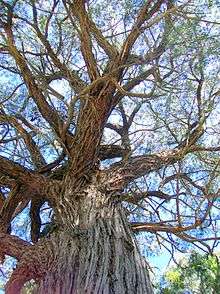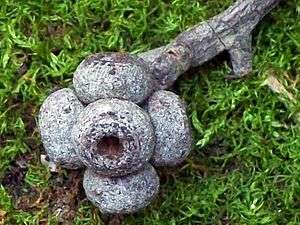Eucalyptus agglomerata
| Blue-leaved stringybark | |
|---|---|
 | |
| Blue-leaved stringybark, Watagans National Park, Australia | |
| Scientific classification | |
| Kingdom: | Plantae |
| Clade: | Angiosperms |
| Clade: | Eudicots |
| Clade: | Rosids |
| Order: | Myrtales |
| Family: | Myrtaceae |
| Genus: | Eucalyptus |
| Species: | E. agglomerata |
| Binomial name | |
| Eucalyptus agglomerata | |
Eucalyptus agglomerata, common name blue-leaved stringybark,[1] is a tree native to eastern Australia. Eucalyptus agglomerata was first described by Joseph Maiden in 1922.[2] Its specific name a Latin adjective for "crowded" and referring to the crowded gumnuts.[3] The type specimen was collected in 1896 by Maiden from Hill Top in the Southern Highlands district of New South Wales.[4]
Blue-leaved stringybark is a koala food tree.[5] A field study conducted in the Campbelltown district southwest of Sydney published in 2000 found that koalas preferred Blue-leaved Stringybark and Grey Gum but only when the two tree species were growing on shale-based rather than sandstone soils.[6] Stringybarks are some of the most difficult of all eucalyptus plants to identify. However, the bluish colour of the leaves makes this species fairly easy to identify.
Description
Blue-leaved stringybark has thick, fibrous stringy bark usually colored grey over reddish brown. From a distance the leaves appear a bluish/green colour. As with many stringybarks, the gumnuts are crowded together without stems. Globose in shape with a very small opening, around 5 mm by 8 mm wide. Flowering takes place from March till August, the white flowers measuring around 1.5 cm (0.6 in) in diameter.[3]
Leaves are alternate on the stem, not in any particular pattern. 7 to 14 cm long, 1.3 to 3 cm wide. They are green or grey-green, perhaps with a glossy sheen, and show up as almost blue when looking above at the foliage. The leaves are the same colour on both sides.
The stringybark is a small to tall tree up to 40 metres[7] (130 ft) tall and a metre wide at the base. It occurs in areas of eastern central and southern New South Wales, and is distributed as far north as Wauchope,[8] to just south of the Victorian border into Croajingolong National Park.
Habitat
The tree is often found on gentle to moderate slopes in the coastal and tableland areas, but it also grows on steep slopes in the Blue Mountains. The soils show a range of types, some of poor quality but mostly of good levels of sub soil moisture. Podosolic soils give best results. The soil types for E. agglomerata are mostly sedimentary, based on shales and sandstones, but sometimes slates.[4]
Climate
The climate for this species is mostly warm humid with rainfall ranges between 700 mm to 1500 mm per year. Frosts are common in the higher altitudes of its range, but absent on the lower coastal habitats. The average high temperature of the warmest month is between 25 and 31 degrees Celsius. The minimum temperature range of the coolest month is from -2 to 6 degrees Celsius. Blue-leaved stringybark is found within 120 kilometres of the sea.[4]
Cultivation
It is not often seen in cultivation but has potential as a windbreak or shelter tree.[3]
Timber
The pale brown sapwood is resistant to lyctus borer. The light brown heartwood is of a moderate fine texture with some interlocking grain. The weight is 930 kilograms per cubic metre. It is slow drying and is used for general building construction and fencing.[4]

References
- ↑ Philip A. Clarke (2012). Australian plants as Aboriginal Tools. Rosenberg Publishing. ISBN 9781922013576.
- ↑ "Eucalyptus agglomerata". Australian Plant Name Index (APNI), IBIS database. Centre for Plant Biodiversity Research, Australian Government.
- 1 2 3 Elliot, Rodger W.; Jones, David L.; Blake, Trevor (1986). "Eu-Go". In Elliot, Rodger W.; Jones, David L. Encyclopaedia of Australian Plants suitable for cultivation. 4. Lothian Publishing. p. 16. ISBN 0-85091-213-X.
- 1 2 3 4 Forest Trees of Australia, D.J. Boland et al. 1992 ISBN 0-909605-57-2 page 282
- ↑ https://www.savethekoala.com/koalastrees.html
- ↑ Phillips, Stephen; Callaghan, John (2000). "Campbelltown". Wildlife Research. 27 (5): 509–16. doi:10.1071/WR98087.
- ↑ http://plantnet.rbgsyd.nsw.gov.au/cgi-bin/NSWfl.pl?page=nswfl&lvl=sp&name=Eucalyptus~agglomerata
- ↑ "Eucalyptus agglomerata". PlantNET - NSW Flora Online. Retrieved 2010-04-12.
- A Field Guide to Eucalypts - Brooker & Kleinig volume 1, ISBN 0-909605-62-9 page 67